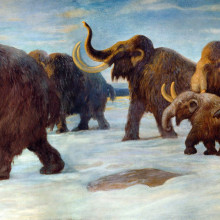This week archaeologists in Queensland, Australia, found part of a fossil from an ancient platypus that was a metre-long. Archaeologists have already found the remains of many giant ancestors of modern creatures, so here's two modern day giant animals - Simon Bishop and Matt Burnett - with this week's Quick Fire Science looking at why animals grew so big in the past.
In this episode

00:00 - Quick Fire Science: Megafauna
Quick Fire Science: Megafauna
This week archaeologists in Queensland, Australia, found part of a fossil from an ancient platypus that was a metre long. Archaeologists have already found the remains of many giant ancestors of modern creatures, so here's two modern day giant animals - Simon Bishop and Matt Burnett - with this week's quick fire science looking at why animals grew so big in the past:
- Giant animals are called megafauna. The definition of megafauna can include kangaroos and even humans, but historically much larger, stranger beasts have roamed the land.
- When the dinosaurs became extinct, previously small animals thrived. Mammals, birds and even fish grew massively to fill the niche.
- Perhaps the best known example of extinct megafauna is the woolly mammoth. These huge elephant-like creatures roamed across North America, Europe and Asia during the last Ice Age, using fur to keep warm.
- Australia in particular has uncovered some impressive mega fauna including the Diprotodon - a wombat the size of a rhino, and Varanus priscus, a monitor lizard that grew up to 7 metres long!
- The decline of megafauna around the world often coincided with the arrival of humans. There were once 4 ton, 6m-long sloths, but they met their end when humans colonised the Americas.
- It is suggested that we hunted many large animals to extinction, but scientists have also suggested the end of the ice age or changes in climate may have caused their disappearance.
- Humans used to be bigger too. Over the past 40,000 years, human body and brain size has decreased because of changes in diet and lifestyle, as we swapped hunting giant beasts to farming tamer, smaller ones.
- But present day megafauna do exist. The blue whale is the largest animal to have ever lived, and there are between 10,000 and 25,000 alive today.
- At 30m in length, with a heart the size of a car and requiring 7 tons of food a day, the blue whale is a true leviathan. The second largest known animal to have lived - the dinosaur Argentinosaurus - was only half the weight of a blue whale.









Comments
Add a comment